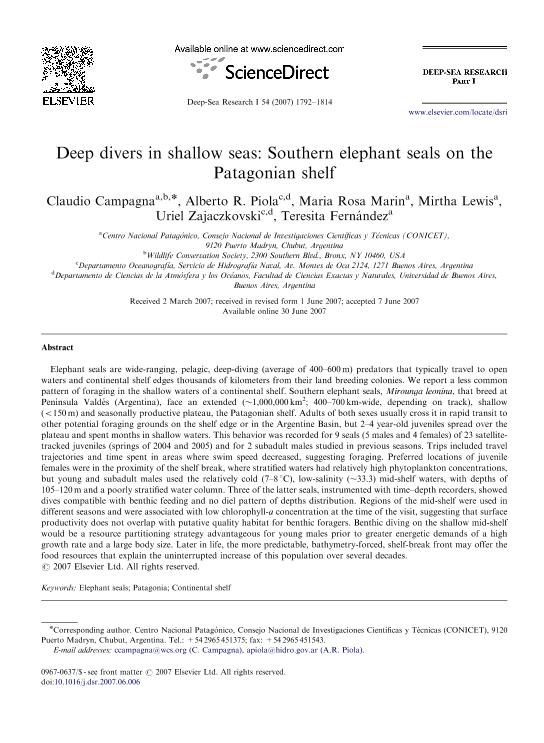Mostrar el registro sencillo del ítem
dc.contributor.author
Campagna, Claudio

dc.contributor.author
Piola, Alberto Ricardo

dc.contributor.author
Marin, Maria Rosa

dc.contributor.author
Lewis, Mirtha Noemi

dc.contributor.author
Zajaczkovski, Uriel

dc.contributor.author
Fernandez, Teresita Josefa

dc.date.available
2020-04-03T16:43:22Z
dc.date.issued
2007-12
dc.identifier.citation
Campagna, Claudio; Piola, Alberto Ricardo; Marin, Maria Rosa; Lewis, Mirtha Noemi; Zajaczkovski, Uriel; et al.; Deep divers in shallow seas: Southern elephant seals on the Patagonian shelf; Pergamon-Elsevier Science Ltd; Deep Sea Research Part I: Oceanographic Research Papers; 54; 12-2007; 1792-1814
dc.identifier.issn
0967-0637
dc.identifier.uri
http://hdl.handle.net/11336/101853
dc.description.abstract
Elephant seals are wide-ranging, pelagic, deep-diving (average of 400–600 m) predators that typically travel to open waters and continental shelf edges thousands of kilometers from their land breeding colonies. We report a less common pattern of foraging in the shallow waters of a continental shelf. Southern elephant seals, Mirounga leonina, that breed at Penı´nsula Valde´s (Argentina), face an extended (1,000,000km2; 400–700 km-wide, depending on track), shallow (o150 m) and seasonally productive plateau, the Patagonian shelf. Adults of both sexes usually cross it in rapid transit to other potential foraging grounds on the shelf edge or in the Argentine Basin, but 2–4 year-old juveniles spread over the plateau and spent months in shallow waters. This behavior was recorded for 9 seals (5 males and 4 females) of 23 satellitetrackedjuveniles (springs of 2004 and 2005) and for 2 subadult males studied in previous seasons. Trips included travel trajectories and time spent in areas where swim speed decreased, suggesting foraging. Preferred locations of juvenile females were in the proximity of the shelf break, where stratified waters had relatively high phytoplankton concentrations, but young and subadult males used the relatively cold (7–8 1C), low-salinity (33.3) mid-shelf waters, with depths of 105–120m and a poorly stratified water column. Three of the latter seals, instrumented with ime–depth recorders, showed dives compatible with benthic feeding and no diel pattern of depths distribution. Regions of the mid-shelf were used in different seasons and were associated with low chlorophyll-a concentration at the time of the visit, suggesting that surface productivity does not overlap with putative quality habitat for benthic foragers. Benthic diving on the shallow mid-shelf would be a resource partitioning strategy advantageous for young males prior to greater energetic demands of a high growth rate and a large body size. Later in life, the more predictable, bathymetry-forced, shelf-break front may offer the food resources that explain the uninterrupted increase of this population over several decades.
dc.format
application/pdf
dc.language.iso
eng
dc.publisher
Pergamon-Elsevier Science Ltd

dc.rights
info:eu-repo/semantics/openAccess
dc.rights.uri
https://creativecommons.org/licenses/by-nc-sa/2.5/ar/
dc.subject
ELEPHANT SEALS
dc.subject
PATAGONIA
dc.subject
CONTINENTAL SHELF
dc.subject
BIOLOGGING
dc.subject.classification
Ecología

dc.subject.classification
Ciencias Biológicas

dc.subject.classification
CIENCIAS NATURALES Y EXACTAS

dc.title
Deep divers in shallow seas: Southern elephant seals on the Patagonian shelf
dc.type
info:eu-repo/semantics/article
dc.type
info:ar-repo/semantics/artículo
dc.type
info:eu-repo/semantics/publishedVersion
dc.date.updated
2020-04-02T14:16:16Z
dc.journal.volume
54
dc.journal.pagination
1792-1814
dc.journal.pais
Estados Unidos

dc.description.fil
Fil: Campagna, Claudio. Consejo Nacional de Investigaciones Científicas y Técnicas. Centro Nacional Patagónico; Argentina
dc.description.fil
Fil: Piola, Alberto Ricardo. Consejo Nacional de Investigaciones Científicas y Técnicas; Argentina. Universidad de Buenos Aires. Facultad de Ciencias Exactas y Naturales. Departamento de Ciencias de la Atmósfera y los Océanos; Argentina
dc.description.fil
Fil: Marin, Maria Rosa. Consejo Nacional de Investigaciones Científicas y Técnicas. Centro Nacional Patagónico; Argentina
dc.description.fil
Fil: Lewis, Mirtha Noemi. Consejo Nacional de Investigaciones Científicas y Técnicas. Centro Nacional Patagónico; Argentina
dc.description.fil
Fil: Zajaczkovski, Uriel. Consejo Nacional de Investigaciones Científicas y Técnicas; Argentina. Universidad de Buenos Aires. Facultad de Ciencias Exactas y Naturales. Departamento de Ciencias de la Atmósfera y los Océanos; Argentina
dc.description.fil
Fil: Fernandez, Teresita Josefa. Consejo Nacional de Investigaciones Científicas y Técnicas. Centro Nacional Patagónico; Argentina
dc.journal.title
Deep Sea Research Part I: Oceanographic Research Papers

dc.relation.alternativeid
info:eu-repo/semantics/altIdentifier/url/https://www.sciencedirect.com/science/article/pii/S0967063707001537
dc.relation.alternativeid
info:eu-repo/semantics/altIdentifier/doi/http://dx.doi.org/10.1016/j.dsr.2007.06.006
Archivos asociados
